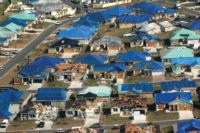The Bright Future of Roofing Restoration












Climate change is upon us and that is going to be really good for roofing contractors. Climate change brings on more severe weather patterns. As a result, unusual weather triggers insurance claims on property insurance policies.
A significant number of all the new roofs installed in the United States are paid for through homeowners’ insurance policies. And who will install all those new roofs? Restoration contractors will be doing that work with increasing volumes every single year.
If you are in the restoration business, you can look forward to decades of increasing demand for your services. To forecast the demand for new roofs paid for through homeowners’ insurance policies, one only has to look at the total amount of carbon dioxide in the atmosphere. Take a look at the charts here. Notice how closely the rate of change on carbon dioxide correlates to insured losses arising from thunderstorms?
These trends in weather patterns show a couple of important things for restoration contractors:
- Business is going to get better.
- Since humans are not going to do anything soon to effectively reduce the effects of carbon dioxide emissions, the roofing business is predictably going to be good for a very long time.
Few lines of work show as much growth potential as roofs paid for through insurance policies. But getting into the roofing business if you are a restoration contractor is not a panacea. Business insurance underwriters will tell you that roofing is a high risk business both from a liability and workers compensation insurance standpoint. This is evident in the insurance premiums roofers pay relative to a fire and water restoration contractor. In some cases, the base rate right out of the underwriting manual is seven times higher for a roofer than it is for a restorer. The insurance rates paid for workers compensation insurance can have a similar differential.
On top of high rates, some insurance companies have underwriting rules that prevent their underwriters from insuring roofers at any price. As a class of business, we see more “glitchy” insurance policies sold to roofers than any type of contractor. We also see an unusual number of roofing firms operating without workers compensation insurance, which is really bad news for restoration firms that hire an uninsured roofer because all of the risk arising from the roofer’s work will land on the restorer. Also, the restorer can get stuck paying workers compensation premiums on the restorer’s work comp policy for the uninsured subcontractor’s payroll.
These insurance constraints on roofing operations are in direct conflict with the contractual insurance requirements under master service agreements with franchisors, networks and insurance companies. Access to business insurance can be the #1 barrier to participating in this rapidly growing roofing restoration marketplace. For this reason, it is very important to discuss with your insurance agent what the implications of going into the self-performed roofing business might be before you actually start doing the work.
Before you give up on the roofing idea, let me share some other interesting statistics on the effects of climate change.
A lot of people think the debate on the cause of global warming is fairly new. Here is a shocker: global warming resulting from burning fossil fuels creating a greenhouse effect by adding carbon dioxide to the atmosphere is not a new idea. A scientist in 1890 at the University of Wisconsin was accurately forecasting what would happen to the temperature of the earth if humans released a lot of CO2 into the atmosphere by burning coal in the industrial revolution. Since we have known about the risks of CO2 for 125 years and did nothing about it, it is a safe bet nothing major will change in the demand for restoration services for a generation or two.
In the meantime, the restoration industry is in for a great ride fixing the effects of global warming for decades to come. If you have your restoration firm actually insured as a restorer and not a janitorial firm, you will be able to slide gracefully into the self-performed roofing business as an extension to the services you already provide. I would expect a slight increase in insurance costs as a percentage of your revenues, but the changes should not be drastic.
If you are thinking of sub-contracting all roofing work out, be aware some roofers have very questionable business insurance in place. I once read a general liability insurance policy on a roofer that had anexclusionfor roofing work. Yes, you read that right. The policy insured their Christmas party but not roofing jobs. The roofer’s insurance agent had provided my client with a certificate of insurance showing general liability insurance was in place, which it was….on the Christmas party.
The moral to the story is if you are hiring roofing subcontractors, tighten up your insurance specifications in the subcontractor agreement and monitor compliance with your insurance specifications. You will need some outside expertise to do that effectively.
For thousands of restorers in the right states, roofing promises to be a long-term source of work. But before diving into a new line of roofing services, I strongly suggest getting your insurance house in order. There are good insurance solutions available for roofing work, but it takes some planning for things to go smoothly in an insurance transition.
The worst possible scenario is to be out looking for replacement insurance after your insurance company has dumped you over a material change in the risk when you went into roofing without telling them. That situation is easy to avoid with a little upfront planning on your part.
Looking for a reprint of this article?
From high-res PDFs to custom plaques, order your copy today!












